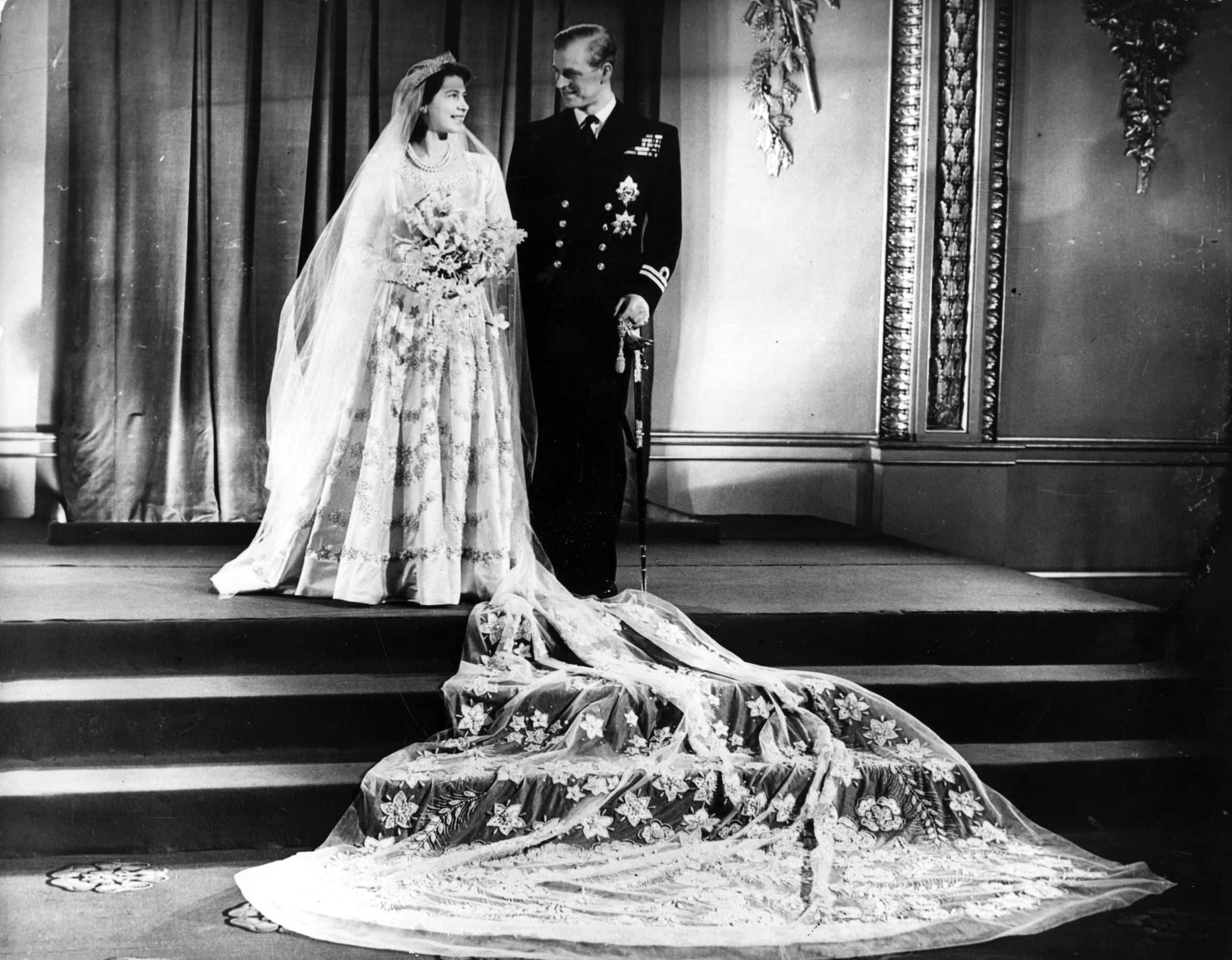By Pauline Weston Thomas for Fashion-Era.com
- Lady Elizabeth Bowes Lyon
- The Duchess of York's Wedding Dress
- Norman Hartnell and Cecil Beaton make a Mystical Image
- The New Queen's Daytime Fashion Transformation
- The Queen Mother's Style of Her Own
Queen Elizabeth the Queen Mother Full Name
Queen Elizabeth The Queen Mother's full birth name was "Elizabeth Angela Marguerite Bowes-Lyon." She was born on August 4, 1900, in London, and died on March 30, 2002. She became the Queen Consort in 1936 when her husband, King George VI, ascended to the throne. After his death in 1952, she was known as The Queen Mother to avoid confusion with her daughter, Queen Elizabeth II.
This picture was taken when she was a young child.
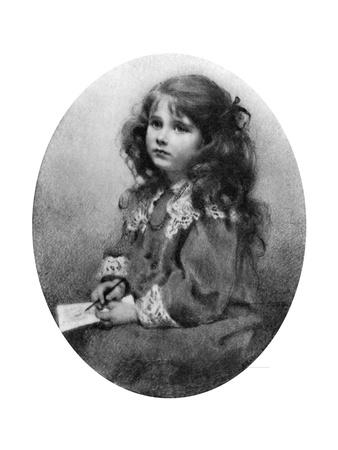
The Duchess of York's Wedding Dress
Queen Elizabeth the Queen Mother's wedding date: Queen Elizabeth The Queen Mother (then Lady Elizabeth Bowes-Lyon) married the Duke of York, who later became King George VI, on April 26, 1923. The wedding took place at Westminster Abbey in London.
On marriage, she became the Duchess of York and fulfilled her first marital duty by bearing him two girls in the early years. When her husband was crowned George VI in 1937 after the abdication of Edward VIII she became his crowned Queen Consort.
Her first daughter Elizabeth became Queen of Great Britain and the Commonwealth in 1952 and was crowned in 1953. Read more on the coronation dress.

This is the wedding photograph of the Duke and Duchess of York on their wedding day.
The dress was designed by Madame Handley Seymour a former London court dressmaker to the dowager Queen Mary. The dress followed the essential fashions of the day, but has never been considered memorable for its beauty.
In 1923 the fashions of the day were not only straight and fairly shapeless but had also cast aside the frills, fabrics and bows of a lost era.
The classic simplicity of the much-copied designs by Chanel did not suit the rounded curvy figure of the duchess.
She looked far better in softer more feminine clothes than the boyish fashions of the day.
Motherhood rounded out her figure even more and although she was charming, pretty, captivating and the right material for a wife of the grandest sort, she was not a naturally glamorous chic woman compared with picture-perfect contemporaries of the era.
The continental Princess Marina the Duchess of Kent exuded a classy style that was hard to beat. Likewise, comparisons were made between the then Duchess of York and Wallis Simpson, the amour of the Prince of Wales. The latter woman made the famous remark "You can never be too rich or too thin", which is one the Duchess of York would certainly have felt directed at her.
In an effort to establish a distinctive fashion style the new King and Queen soon summoned Norman Hartnell into royal service.
Norman Hartnell and Cecil Beaton Make a Mystical Image
Norman Hartnell had a dressmaking business operating from four small rooms in Bruton Street in London.
On his first visit to Buckingham Palace in January 1937 the new King showed him several Victorian Winterhalter paintings leaving Hartnell with a strong impression that they should be the source of inspiration for designing the new Queen's evening gowns.
The Queen's new crinoline-style evening gowns were first seen in public in November 1937 and they flattered her enormously, bringing an elongation to a body not as model-like in real life as sketches by Hartnell suggested.
In the summer of 1938 Queen Elizabeth's mother, Lady Strathmore died. A state visit to Paris was already planned and after a brief delay, it went ahead a few weeks later.
In that time Hartnell and his team worked around the clock to to reproduce a new wardrobe based on more than 30 designs already prepared in a range of colours. The new order was now made up totally in white, an alternative royal mourning colour.
Queen Elizabeth charmed the Parisians with her fresh perfect complexion and the layered white floaty dresses in styles that suited her and made her look a picture of assured confidence in the French sun. The theatrical sentimental styles suited her well and she never abandoned them once their success was well established.
Parisian approval and a realization that the calculated sentimental look had worked, was more than enough for any Queen. She understood public relations and thereafter continued to dress in a style that suggested wholesomeness, steadfastness, warmth, sweetness and lovability. She became what she invented, a picture that said goodness and stability.
Inevitably photographs of her by Cecil Beaton wearing the Hartnell creations helped create a more enigmatic vision in the public's eye. It's alleged that she was not averse to a little airbrushing to help define her waistline in the cause of good public relations.
The New Queen's Daytime Fashion Transformation
Hartnell was less successful in transforming the new Queen into a daytime mannequin. Her diminutive height(Queen Elizabeth The Queen Mother's height is not officially documented in precise measurements like many royal statistics. However, it is generally accepted that she stood at about 5 feet 2 inches (157.5 cm) tall.), short legs and less-than-slender ankles made it hard for him to transform the matronly appearance into the model look chic of his sketches. She was still something of a sartorial challenge in everyday clothes. Rescue came in the form of wartime austerity.
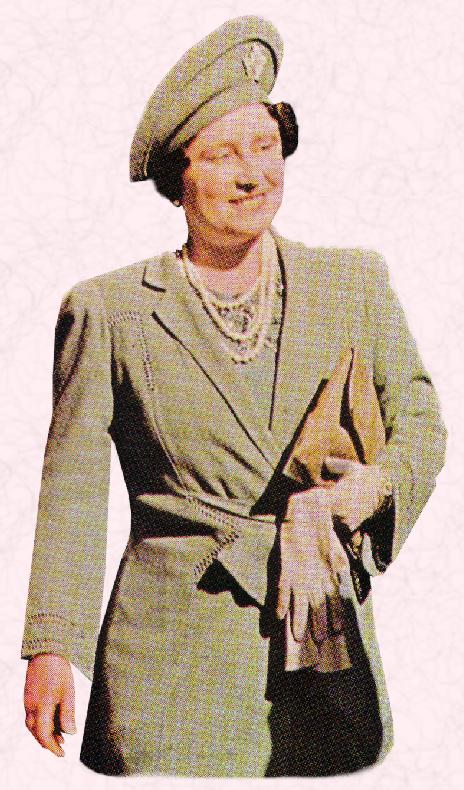
The Queen decided to pare down fussiness in her clothes and follow government guidelines for dressing down in Britain making do with clothing coupons, regulated cloth, seams, and trimmings.
She toured bomb-damaged sites in coordinating but simple unfussy outfits, usually of dress and matching coat and hat, that any groomed woman of standing with money might have worn.
The clean lines of the daytime clothes won out whereas clothes designed for a woman with the figure of a slender, but untouchable film star had not. Queen Elizabeth's new clothes for day were often in lighter colours and were embellished in a less ornate way.
Click the thumbnail below to see the detail of the drawn threadwork on the Khaki coat. It is so subtle, yet so stylish in a classic way, and would not have caused offence to anyone in uniform as conspicuous wastage or conspicuous consumption.
The Queen Mother's Style Of Her Own
Well after the war she followed her instinct and favoured matching coats and dresses. Almost always they had a V neckline that elongated her neckline, providing a setting for her famous jewellery whether pearls or sumptuous parures.
As she aged certain features became usual.
For example, soft pleats or gathers from the shoulder suit a more matronly silhouette and a body that is essentially being pulled down by gravity.
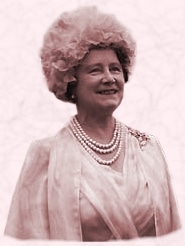
Sleeves were often three-quarter or elbow length and designed to draw attention to interesting edge finishes and take the eye away from the figure.
Feather hats, swathes of chiffon, and beautiful artificial flowers amid sweeping brims continued to mark her style until her death at 101 years of age on 30 March 2002.
Her Majesty Queen Elizabeth II's Fashion History Exhibition
Queen's Clothes Exhibition to Celebrate The Queen’s 80th Birthday 26 July to 24 September 2006
See an exhibition 'Dress for the Occasion' of 80 of Her Majesty’s evening dresses and personal jewelry. The fashion history exhibition which began at the Summer Opening of Buckingham Palace shows the fashion history of a revered and modern Queen's important often bejeweled gowns.
Clothes from the 1940s to today are displayed and feature all the Queen's most famous designers, including Norman Hartnell and Hardy Amies. In her twenties, the Queen had a handspan waist. Those super slender waist gowns are shown on dress forms each crafted using the Queen’s original measurements.
Dress for the Occasion is an exhibition that features 80 evening gowns to celebrate the Queen's 80th birthday.
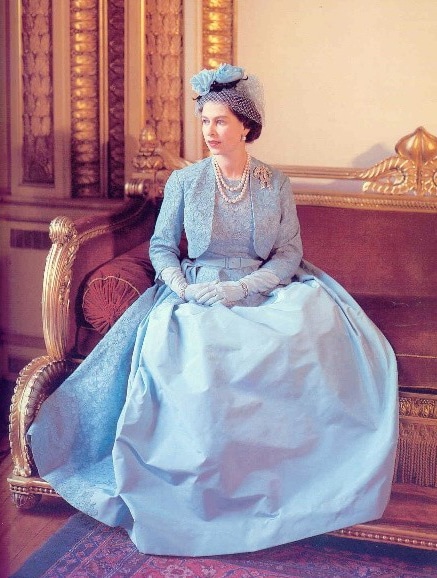
Caroline de Guitaut is the curator of the exhibition and has arranged the 80 dresses since the 1940s in colour groups and a neutral section of creams and whites.
The dresses also show how the queen’s figure has changed from slender young girl to a mature stately woman.
The jewelled embroidered green silk dress dress above was designed by Norman Hartnell. It is an example of a typically fabulous gown designed for the state visit to Ethiopia in February 1965.
The Queen's Wardrobe
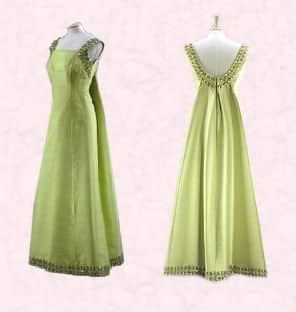

The Queen’s wardrobe represents a working wardrobe designed for maximum visibility. For half a century her clothes have been used as an expression of diplomatic gesture. Never mind the film, ‘If It’s Tuesday This Must Be Belgium’, for the Queen if she is in Japan there must be a recognition of the emblematic cherry blossom, or if in Canada there must be acknowledgement of maple leaves. The emblematic flora and fauna of a host country or special guest wherever she may be, is delicately hinted at somewhere in the gown, the fabric print or trimmings.
Her Majesty knows her flag colours well too. She shows the greatest diplomatic touches in honouring other countries by wearing those same flag colours in her clothes. Her wardrobe is invariably dictated by such diplomatic gestures to other countries. This has resulted in the making of some truly fabulous strongly coloured gowns over the years.
There is also a need for neutral-toned gowns as they are a perfect foil for gaudy sashes and other regalia. These satin dresses left and embroidered with gold, diamanté and pearls by Norman Hartnell are good foils for strongly clashing garter sashes.
Her evening and state gowns have often been works of art with sumptuous embroidery and fine embellishments. More of the Queen's gowns are shown on the Queen & Commonwealth: The Royal Tour 2009.
Many of Queen Elizabeth's dresses have been simply stunning, adding not celebrity bling, but just a touch of tastefully acceptable glamour for a woman who is not an actress, yet finds herself constantly in the public eye.
Her clothes whether day or evening always suit the occasion. They still look appropriate and regal in photographs years later. They pay a small tribute to well-established fashion trends, but the styles never stray too far into fads that might look like the worst excesses of an era 10 years later. Any exhibition of Her Majesty’s clothes is always an eye opener as you notice the quality and richness of colour of the heavy satins, the exquisite beading and somewhat amazingly how very tiny her waist was in the earlier years of her reign.
Whenever I get an opportunity to see the Queen’s clothes at an exhibition I jump at the chance to study them closer.
Dress for the Occasion is an exhibition of Fashion History in the making – simply wonderful.
Copyright Pauline Weston Thomas - Editor in Chief www.fashion-era.com
Exhibition which begins at the Summer Opening of Buckingham Palace 26 July 2006 will show clothes from the 1940s to today and feature all the Queen's most famous designers. Dress for the Occasion exhibition runs until September 24 2006 at Buckingham Palace State Rooms, London SW1 (020-7766 7300. www.royalcollection.org.uk.
